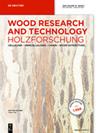A new look at the kinetics of oxygen delignification of softwood kraft pulp
IF 1.6
3区 农林科学
Q2 FORESTRY
引用次数: 1
Abstract
Abstract Using a Berty-type CSTR reactor, Ji (2007. Kinetics and mechanism of oxygen delignification, Ph.D. thesis. The University of Maine) obtained oxygen delignification kinetics first order in lignin when neglecting the higher initial delignification phase. In the present study the same Berty/CSTR reactor with an improved temperature control was used to determine the oxygen delignification kinetics of Southern Pine kraft pulp, with the kinetics now corrected for lignin removed by oxygen-free alkaline leaching. This removes the initial high delignification rate peak so that the kinetics over the entire lignin range can be modelled as first order in “reactive” lignin, which is lignin corrected for a small amount of unreactive lignin. It suggests that softwood pulp oxygen delignification consists of two contributions; phenolic delignification and alkaline leaching. The initial alkaline leaching phase is mathematically described by semi-infinite alkaline diffusion of dissolved lignin trapped in the cell wall after pulp washing. For phenolic delignification, the reaction orders in alkali concentration and oxygen of the power law delignification equation are 0.3 and 0.44 respectively, while the activation energy is 63 kJ/mol. Taking into account the unreactive HexA, the small amount of unreactive lignin, and the lignin removed by alkaline leaching, the kappa number is well predicted by the new delignification kinetics.软木硫酸盐浆氧脱木素动力学新探
摘要使用Berty型CSTR反应器,Ji(2007。氧脱木素动力学与机理,博士论文。The University of Maine)在忽略较高的初始脱木素阶段时获得了木质素中的氧脱木素动力学一级。在本研究中,使用具有改进的温度控制的相同Berty/CSTR反应器来确定Southern Pine硫酸盐浆的氧脱木素动力学,现在对通过无氧碱性浸出去除木质素的动力学进行校正。这消除了最初的高脱木素速率峰值,从而可以将整个木质素范围内的动力学建模为“反应性”木质素中的一级动力学,即对少量未反应木质素进行校正的木质素。结果表明,软木纸浆氧脱木素主要有两个方面的贡献;苯酚脱木素和碱性浸出。初始碱性浸出阶段在数学上通过纸浆洗涤后截留在细胞壁中的溶解木质素的半无限碱性扩散来描述。对于酚类脱木素,幂律脱木素方程在碱浓度和氧浓度下的反应级数分别为0.3和0.44,而活化能为63 kJ/mol。考虑到未反应的HexA、少量未反应的木质素和碱浸去除的木质素,新的脱木素动力学很好地预测了卡伯值。
本文章由计算机程序翻译,如有差异,请以英文原文为准。
求助全文
约1分钟内获得全文
求助全文
来源期刊

Holzforschung
工程技术-材料科学:纸与木材
CiteScore
4.60
自引率
4.20%
发文量
83
审稿时长
3.3 months
期刊介绍:
Holzforschung is an international scholarly journal that publishes cutting-edge research on the biology, chemistry, physics and technology of wood and wood components. High quality papers about biotechnology and tree genetics are also welcome. Rated year after year as one of the top scientific journals in the category of Pulp and Paper (ISI Journal Citation Index), Holzforschung represents innovative, high quality basic and applied research. The German title reflects the journal''s origins in a long scientific tradition, but all articles are published in English to stimulate and promote cooperation between experts all over the world. Ahead-of-print publishing ensures fastest possible knowledge transfer.
 求助内容:
求助内容: 应助结果提醒方式:
应助结果提醒方式:


